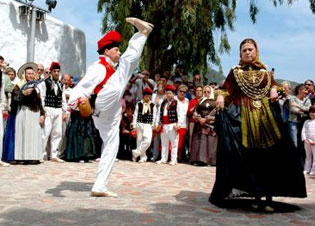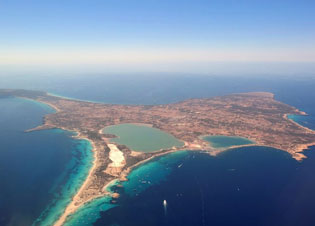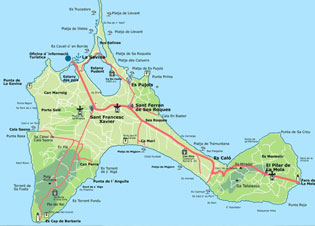
The history of Formentera: from ancient times to today, including pirates and hippies!
Reconstructing the history of Formentera, the events that saw it as a protagonist and the people who have inhabited it is quite a difficult task. In fact, there are very few tangible and verified testimonies that faithfully reconstruct the history of this piece of land.
Ancient Age
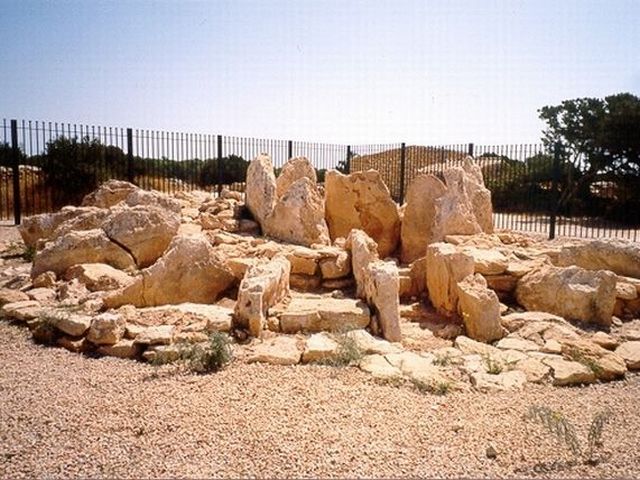
Megalithic sepulchre of Ca Na Costa
The megalithic sepulchre of Ca Na Costa is a concrete trace of one of the first settlements. Located on the road that leads from Es Pujols to the port of La Savina, it was discovered only a few decades ago, in 1974. A sign of an early civilisation on the island, it is a multiple burial site, perhaps the largest in the Balearic Islands.
Dated between 1900 BC and 1600 BC, it has a circular plan and contains a burial chamber enclosed by 3 stone circles. Unfortunately, time and atmospheric agents have severely damaged this ancient site, and what is left now are only a few remains.
Later, in 654 BC, the Phoenicians and Carthaginians established a large colony in Ibiza that was to become one of the most influential in the entire Mediterranean Sea, but unfortunately nothing is known about the passage of these peoples on the nearby island of Formentera. The only certainty from that period is that it was precisely they who gave the name Pityusic Islands, which means “islands of the pines”, to Ibiza and Formentera. The massive presence of these shrubs on both islands affected the inhabitants of the time so much that they coined the collective name.
Since then, traces of the villages or small human settlements that inhabited the island have been lost. Evidence subsequent to that period is, therefore, the passage of the Romans who built the Castle of Can Blai, which can be dated to between the 3rd and 4th centuries.
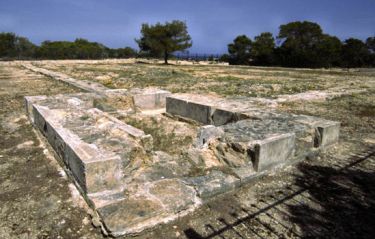
Remains of the Roman castle of Can Blai
Located along the road that links La Savina with La Mola, around km. 10, here too we are faced with a few archaeological remains. You can admire parts of the perimeter walls and the ruins of the five watchtowers that once served as guard posts. Because of its layout, it has been compared to similar buildings in Romania, Syria, Tunisia and Palestine, all bordering the Roman Empire.
The last studies, in the late 1980s, revealed that the building was probably intended for private use and served as a temporary shelter for the inhabitants of the neighbouring islands. The site was declared a Site of Cultural Interest in 1994.
The name Formentera is also attributed to the Romans. Its origin comes from the Latin word “Frumentaria”, that is to say, the island of wheat, due to the large quantity of grain present.
Medieval Age
Abandoned by the Romans after the fall of the Empire, Formentera did not have a stable domination and a homogeneous population. For a long time, traces of it were lost, until it fell under the control of the Moors: it was here that it experienced centuries of remarkable prosperity.
Indeed, the art of building dry stone walls is attributed to this population. Built only with the help of local stones skilfully laid on top of each other, they have been able to resist for centuries and are still a distinctive feature of local architecture today.
These fences, of the most varied sizes (extended only in length and never in height), had multiple functions: from the delimitation of the territory to the separation of areas destined for different uses. The great peculiarity lies in the fact that neither mud nor other binding materials are used to erect one.
In 1200, the Catalan army ousted the Moors and in 1235 the island was incorporated into the Kingdom of Aragon by King Jaume I. Later, in 1256, James II established the Kingdom of Mallorca, which was, however, short-lived. After less than 100 years, the island once again became part of the Kingdom of Aragon. It was only in 1469, with the marriage between Isabella I of Castile and Ferdinand II of Aragon, that the foundations were laid for the unification of the lands of Spain.
Modern Age
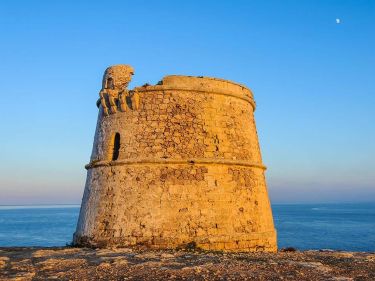
Des Garroveret Tower
A major historical event contributed in the years immediately following to obscure the life of the small island. When, in 1492, Christopher Columbus discovered America, the great traffic of goods and business that revolved around the Mediterranean was substantially reduced. All the interest of the Spanish crown was inevitably diverted towards the new continent and the nascent colonies on the other side of the ocean. Formentera was thus forgotten and the few inhabitants were left at the mercy of pirates.
It was only in the 18th century that the population of Ibiza began to take a renewed interest in its smaller sister Formentera. It was during this period that a radical repopulation allowed the island to build a true identity, made up not only of agriculture and fishing, but also of a social fabric that was progressively consolidated thanks to the growing interactions between the inhabitants.
The first traditional dances and songs date back to this period, which, as in every culture, tell ancient stories so as not to forget the origins of the place and its people. These small demonstrations took place in private homes or, more often, outside the church on feast days. Peculiar is the fact that, movements and customs are not attributable to the traditions established in the nearby islands.
Here, above all, a layering of stories and customs emerges, which are due to the turbulent events of the island and its inhabitants. Even today it is possible to admire traditional dance groups that perform during the island’s main festivals: Sant Ferran on 30 May, St. John the Baptist on 24 June, Our Lady of Mount Carmel on 16 July, St. James on 25 July, Our Lady of the Snows on 5 August, Our Lady of the Pillar on 12 October and Sant Francesc on 3 December.
Contemporary age
But it is undoubtedly since the 1970s that Formentera has acquired more modern characteristics and peculiarities. The arrival of the hippies, called by the natives “peludos” (longhairs in spanish), made this island the preferred destination for anyone looking for a place that was still unspoilt and wild. Dirt roads and lack of electricity made it possible to live simply and in contact with nature.
Young people from all over the world came here, consumed by the new synthetic drugs or holy men in search of their lost identity. Even today, at Fonda Pepe, a historic hippy hangout in Sant Ferran, you can still savour the free and relaxed atmosphere that makes Formentera the last paradise of the Mediterranean.
We have come to the conclusion of this long excursus on the history of Formentera. We don’t know what the future holds for the island, but we are sure that its magic will remain unique.
YOU MAY ALSO LIKE:
“Every trip you live three times:
when you dream it,
when you live it
and when you remember it. “
PROMOTIONAL CODE
CODICE PROMOZIONALE
Book online using the promotional code ESTATE123 and save with our partners. The code is valid for EVERYONE. You can take advantage of the discounts even if we were unable to provide the right accommodation for you.









